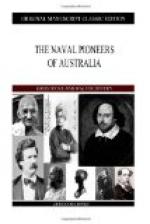One incident in the matter of Cook’s appointment should be noted in this connection. The command of the expedition was at first intended for Dalrymple, the celebrated geographer and then chief hydrographer to the Admiralty. The precedent of Halley’s command of the Paramour in 1698 had taught a lesson of the danger of giving the command of a ship to a landsman, and Sir Edward (afterwards Lord) Hawke, First Lord of the Admiralty in 1768, said, to his everlasting credit, that he would sooner cut off his right hand than sign a commission for any person who had not been bred a seaman. Dalrymple, there is little doubt, never forgave Cook for taking his place, and later on showed his resentment by an unfair statement which will be presently alluded to.
The Endeavour was what was then known as a “cat-built” ship, of 368 tons burden, a description of vessel then much used in [Sidenote: 1768] the Baltic and coal trade, having large carrying capacity, with small draught. A pencil sketch by Buchan (one of the artists who accompanied Cook) of her hull, lying at Deptford, shows the short, stumpy north-country collier, of which even nowadays one may occasionally see specimens afloat. Her great, square stern has a row of four glazed windows, alternated with ornamental panels and surrounded by scroll work, and two square ports underneath them close to the water’s edge, probably for loading and unloading Baltic timber. The usual stern-lantern “tops off” the structure. There is a framework for a quarterdeck extending to the waist and the frame of a topgallant poop above this, Buchan probably having made the sketch when she was refitting for the voyage and this structure being erected for the accommodation of the officers.
Cook was appointed a first lieutenant in the navy and commander of the Endeavour on May 25th, 1768, and his ship’s company, all told, numbered eighty-five persons.
Sir Joseph Banks (then plain Mr.), Green the astronomer, Dr. Solander the naturalist, two draughtsmen, and a staff of servants were also on board. The ship, for defence against savages it is to be presumed, carried ten four-pound carriage guns and twelve swivels. The food supply was for eighteen months, and consisted of beef, pork, peas, oatmeal, butter, cheese, oil, vinegar, beer, and brandy, and included materials for Dr. McBride’s method of treating the scurvy. The Admiralty gave Cook a special order on this matter, in which they say:—
“The malt must be ground under the direction of the surgeon, and made into wort (fresh every day, especially in hot weather) in the following manner viz.: Take one quart of ground malt and pour on it three quarts of boiling water; stir them well, and let the mixture stand close covered up for three or four hours, after which strain off the liquor.
“The wort so prepared is then to be boiled into a panada with sea-biscuit or




